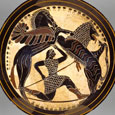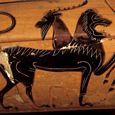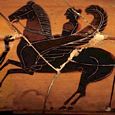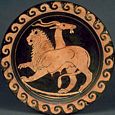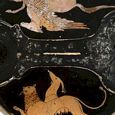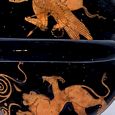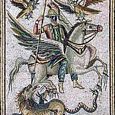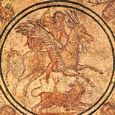The hero Bellerophon was commanded to slay it by King Iobates. He rode into battle against the beast on the back of the winged horse Pegasos and, driving a lead-tipped lance down the Khimaira's flaming throat, suffocated it.
The Khimaira may have once been identified with the winter-rising Constellation Capricorn (the serpent-tailed goat). The constellation Pegasos appears to drive her from the heavens in spring.
Late classical writers represent the beast as a metaphor for a Lycian volcano.
| PARENTS |
| TYPHOEUS & EKHIDNA (Hesiod Theogony 319, Homeric Hymn 3.356, Apollodorus 2.32 & Hyginus Pref & Fabulae 151) |
| OFFSPRING |
| SPHINX, NEMEIAN LION (by Orthos) (Hesiod Theogony 327) |
Homer, Iliad 6. 179 ff (trans. Lattimore) (Greek epic C8th B.C.) :
"First he [Iobates] sent him [Bellerophon] away with orders to kill the Khimaira none might approach; a thing of immortal make, not human, lion-fronted and snake behind, a goat in the middle, and snorting out the breath of the terrible flame of bright fire. He killed the Khimaira, obeying the portents of the immortals."
Homer, Iliad 16. 328 ff :
"Amisodaros, the one who had nourished the furious Khimaira to be an evil to many."
Hesiod, Theogony 319 ff (trans. Evelyn-White) (Greek epic C8th or C7th B.C.) :
"She [Ekhidna] bore the Khimaira, who snorted raging fire, a beast great and terrible, and strong and swift-footed. Her heads were three: one was that of a glare-eyed lion, one of a goat, and the third of a snake, a powerful drakon. But Khimaira (Icy-Air) was killed by Pegasos (Spring)and gallant Bellerophon. But she also, in love with Orthos (Morning Twilight), mothered the deadly Sphinx . . . and the Nemeian Lion."
Hesiod, Catalogues of Women Fragment 7 (trans. Evelyn-White) (Greek epic C8th or C7th B.C.) :
"With him [Pegasos] Bellerophon caught and slew the fire-breathing Khimaira."
Homeric Hymn 3 to Apollo 356 ff (trans. Evelyn-White) (Greek epic C7th - 4th B.C.) :
"Phoibos Apollon boasted over her [the Drakaina Python] `. . . Against cruel death neither Typhoeus [her consort] shall avail you nor ill-famed Khimaira [her spawn], but here, shall the Earth and shining Hyperion make you rot (pytho)."
Pindar, Olympian Ode 13 ep 4 (trans. Conway) (Greek lyric C5th B.C.) :
"And [Bellerophon] felled Khimaira breathing fire."
Plato, Republic 588c (trans. Shorey) (Greek philosopher C4th B.C.) :
“One of those natures that the ancient fables tell of, as that of the Khimaira or Skylla or Kerberos, and the numerous other examples that are told of many forms grown together in one.”
|
|
|
|
Pseudo-Apollodorus, Bibliotheca 2. 31 - 32 (trans. Aldrich) (Greek mythographer C2nd A.D.) :
"He [Iobates] ordered Bellerophon to slay the Khimaira, assuming that he would instead be destroyed himself by the beast, since not even a quantity of men could subdue it with ease, let alone one. For it was a single being that had the force of three beasts, the front part of a lion, the tail of a drakon, and the third (middle) head was that of a goat, through which it breathed out fire. It despoiled the countryside and ravaged the herds. It was allegedly reared by Amisodaros, as Homer also states, and according to Hesiod its parents were Typhon and Ekhidna. Bellerophon mounted Pegasos, his winged horse born of Medousa and Poseidon, and flying high into the air brought down the Khimaira with his bow and arrows."
Pseudo-Apollodorus, Bibliotheca 1. 85 :
"Bellerophon, slayer of the fire-breathing Khimaira."
Strabo, Geography 14. 3. 5 (trans. Jones) (Greek geographer C1st B.C. to C1st A.D.) :
"Kragos [a coastal mountain in Lykia], which has eight promontories and a city of the same name. The scene of the myth of Khimaira is laid in the neighborhood of these mountains. Khimaira, a ravine extending up from the shore, is not far from them."
Pausanias, Description of Greece 2. 27. 2 (trans. Jones) (Greek travelogue C2nd A.D.) :
"[On the throne of Asklepios at Epidauros, Argos] are wrought in relief the exploits of Argive heroes, that of Bellerophontes against the Khimaira."
Pausanias, Description of Greece 3. 18. 10 - 16 :
"[Illustrated on the throne of the statue of Apollon at Amyklai, Lakedaimon :] On the left stand Ekhidna and Typhos, on the right Tritones . . . Bellerophontes is destroying the beast in Lykia [Khimaira]."
Diodorus Siculus, Library of History Book 6 Fragment 9 (trans. Oldfather) (Greek historian C1st B.C.) :
"Iobates [king of Lykia] received the letter [from his son-in-law Proitos] and discovered it was written that he should slay Bellerophon with all speed; but, being unwilling to put him to death, he commanded him instead to go join combat with the fire-breathing Khimaira."
Aelian, On Animals 9. 23 (trans. Scholfield) (Greek natural history C2nd A.D.) :
"Homer may sing of the Khimaira with its three heads, the monster of Lykia kept by Amisodaros the Lykian king for the destruction of many, of varies nature, and absolutely invincible. Now these seem to have been relegated to the region of myths."
|
|
|
|
Pseudo-Hyginus, Fabulae 57 (trans. Grant) (Roman mythographer C2nd A.D.) :
"Iobates was reluctant to kill the hero [Bellerophon], but sent him to kill the Chimaera, a three-formed creature said to breathe forth fire. Likewise: forepart lion, rearpart snake, middle she-goat. This he slew, riding on Pegasus, and he is said to have fallen in the Aleian plains and to have dislocated his hip."
Pseudo-Hyginus, Fabulae 151 :
"From Typhon the giant and Echidna were born . . . the Chimaera in Lycia which had the fore part of a lion, the hind part of a snake, while the she-goat itself formed the middle."
Pseudo-Hyginus, Astronomica 2. 18 (trans. Grant) (Roman mythographer C2nd A.D.) :
"[Proetus King of Argos] knowing that he [Bellerophon] had the horse Pegasus, sent him to the father of Antia (some call her Sthenoboea), for him to defend his daughter’s chastity and send the youth against the Chimaera, which at that time was laying waste with flames the country of the Lycians."
Ovid, Metamorphoses 6. 339 (trans. Melville) (Roman epic C1st B.C. to C1st A.D.) :
"Lycia, the Chimaera’s land." - Ovid, Metamorphoses 6.339
Ovid, Metamorphoses 9. 647 :
"Lycia . . . and the scarp where the Chimaera prowled with lungs of fire and lion’s breast and head and serpent’s tail."
Virgil, Aeneid 6. 287 ff (trans. Fairclough) (Roman epic C1st B.C.) :
"Many monstrous forms besides of various beasts are stalled at the doors [of Haides], Centauri and double-shaped Scyllae, and the hundredfold Briareus, and the beast of Lerna, hissing horribly, and the Chimaera armed with flame, Gorgones and Harpyiae, and the shape of the three-bodied shade [Geryon]."
Cicero, De Natura Deorum 2. 2 (trans. Rackham) (Roman rhetorician C1st B.C.) :
"Who [in this day and age] believes that the Hippocentaurus or the Chimaera ever existed? . . . The years obliterate the inventions of the imagination, but confirm the judgements of nature."
Pliny the Elder, Natural History 5. 100 (trans. Rackham) (Roman encyclopedia C1st A.D.) :
"[In Lycia is] is Mount Chimaera, which sends forth flames at night, and the city-state of Hephaestium [of the fire-god Hephaistos], which also has a mountain range that is often on fire."
Seneca, Medea 828 ff (trans. Miller) (Roman tragedy C1st A.D.) :
"[The witch Medea employs various fabulous ingredients in a spell to create magical fire:] I have gifts from Chimaera’s middle part, I have flames caught from the bull’s [the bronze Kolkhian bull's] scorched throat."
Apuleius, The Golden Ass 8. 16 ff (trans. Walsh) (Roman novel C2nd A.D.) :
"I reflected that it was panic more than anything which had induced the celebrated Pegasus to take to the air, and that the tradition that he had wings was justified because he leapt upward as high as heaven in his fear of being bitten by the fire-breathing Chimaera."
Oppian, Cynegetica 1. 225 (trans. Mair) (Greek poet C3rd A.D.) :
"To Horses beyond all mortal creatures cunning Nature has given a subtle mind and heart . . . A horse [Pegasos] carried above the clouds him [Bellerophon] that slew the Khimaira."
| Greek Name | Transliteration | Latin Spelling | Translation |
| TrikefaloV | Trikephalos | Tricephalus | Three-headed |
| Triswmatos | Trisômatos | Trisomatus | Three-bodied |
NOTES :
The Khimaira may have symbolised the cold of winter: her fire-breathing lion-head representing frost, her goat-head the storms of winter (aigis in Greek means both goatish and storm), and her serpentine-head winter sickness. Khimaira's name appears to be derived from the Greek words kheima (cold, frost, winter) and aera (air). The father of Khimaira was Typhoeus the Daemon of deadly, winter-storms and her mother was Ekhidna a Daemon of illness and disease.
In the popular myth, her opponent Pegasos has a place amongst the stars as the spring-rising constellation Pegasus. Conversely, the Khimaira may have been represented by constellation Capricorn (the serpent-tailed goat), whose rising heralded the onset of winter.
A Greco-Roman mosaic recently unearthed in Syria (Z44.1 above) indicates that the famous medieval scene of St George and the Dragon was derived from ancient Greco-Roman depictions of Bellerophon spearing the Khimaira from the back of Pegasos.
